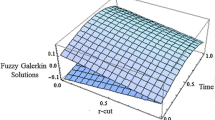Abstract
In this paper, we discuss the numerical solution of second-order nonlinear two-point fuzzy boundary value problems (TPFBVP) by combining the finite difference method with Newton’s method. Numerical example using the well-known nonlinear TPFBVP is presented to show the capability of the new method in this regard and the results are satisfied the convex triangular fuzzy number. We also compare the numerical results with the exact solution, and it shows that the proposed method is good approximation for the analytic solution of the given TPFBVP.




Similar content being viewed by others
References
Seikkala S (1987) On the fuzzy initial value problem. Fuzzy Set Syst 24(3):319–330
Abu Arqub O, Al-Smadi M, Momani S, Hayat T (2016) Application of reproducing kernel algorithm for solving second-order, two-point fuzzy boundary value problems. Soft Comput. doi:10.1007/s00500-016-2262-3
Abu Arqub O, Al-Smadi M, Momani S, Hayat T (2015) Numerical solutions of fuzzy differential equations using reproducing kernel Hilbert space method. Soft Comput 20(2016):3283–3302. doi:10.1007/s00500-015-1707-4
Abu Arqub O (2016) The reproducing kernel algorithm for handling differential algebraic systems of ordinary differential equations. Math Methods Appl Sci 39(2016):4549–4562. doi:10.1002/mma.3884
Abu Arqub O (2016) Approximate solutions of DASs with nonclassical boundary conditions using novel reproducing kernel algorithm. Fundam Inf 146(3):231–254
Usmani RA (1978) Discrete methods for a boundary value problem with engineering applications. Math Comput 32:1087–1096
Ghosh S, Roy D (2007) Numeric-analytic form of the adomian decomposition method for two-point boundary value problems in nonlinear mechanics. J Eng Mech 133(10):1124–1133
Ray Mahapatra T, Gupta AS (2002) Heat transfer in stagnation-point flow towards a stretching sheet. Heat Mass Transf 38(6):517–552
Sharma R, Ishak A, Pop I (2013) Partial slip flow and heat transfer over a stretching sheet in a nano fluid. Math Probl Eng 2013:1–7. doi:10.1155/2013/724547
Kopteva N, Madden N, Stynes M (2005) Grid equidistribution for reaction-diffusion problems in one dimension. Numer Algorithms 40(30):305–322
Kopteva N, Stynes M (2001) A robust adaptive method for a quasilinear one-dimensional convection-diffusion problem. SIAM J Numer Anal 39:1446–1467
Schlögl F (1972) Chemical reaction models for non-equilibrium phase transitions. Z Physik 253:147–161
Fukui K (1981) The path of chemical reactions—the IRC approach. Chem Res 14(12):363–368
Goebel M, Raitums U (1990) Optimal control of two point boundary value problems. Control Inf Sci 143:281–290
Popescu M (2011) Two-point boundary value problem of control systems with parameter. Comput Control Appl (CCCA) IEEE 29:1–6. doi:10.1109/CCCA.2011.6031421
Omer A, Omer O (2013) A pray and pretdour model with fuzzy intial values. Hacet J Math Stat 41(3):387–395
Tapaswini S, Chakraverty S (2013) Numerical solution of fuzzy arbitrary order predator–prey equations. Appl Appl Math 8(1):647–673
Muhammad ZA, De Baets B (2009) Predator–prey model with fuzzy initial populations. In: International fuzzy systems association world congress and European society of fuzzy logic and technology conference, Lisbon, Portugal, July 20–24, IFSA-EUSFLAT, pp 1311–1314
El Naschie MS (2005) From Experimental quantum optics to quantum gravity via a fuzzy Kahler manifold. Chaos Solut Fractals 25:969–977
Abbod MF, Von Keyserlingk DG, Linkens DA, Mahfouf M (2011) Survey of utilization of fuzzy technology in medicine and healthcare. Fuzzy Set Syst 120:331–349
Barro B, Marin R (2002) Fuzzy logic in medicine. Physica, Heidelberg
Allahviranloo T, Khalilpour K (2011) Numerical method for two-point fuzzy boundary value problems. World Appl Sci J 13(10):2137–2147
Jameel AF, Sarmad JA (2015) Numerical solution of linear Emden fowler boundary value problem in fuzzy environment. J Math Comput Sci 15:179–194
Allahviranloo T, Khalilpour K (2011) An initial-value method for two-point fuzzy boundary value problems. World Appl Sci J 13(10):2148–2155
Bodjanova S (2006) Median alpha-levels of a fuzzy number. Fuzzy Set Syst 157(7):879–891
Dubois D, Prade H (1982) Towards fuzzy differential calculus. Part 3: differentiation. Fuzzy Set Syst 8:225–233
Mansouri S, Ahmady N (2012) Numerical method for solving Nth-order fuzzy differential equation by using characterization theorem. Commun Numer Anal 2012:1–12
Ghanbari M (2009) Numerical solution of fuzzy initial value problems under generalization differentiability by HPM. Int J Ind Math 1(1):19–39
Fard OS (2009) An iterative scheme for the solution of generalized system of linear fuzzy differential equations. World Appl Sci J 7:1597–11604
Zadeh LA (2005) Toward a generalized theory of uncertainty. Inf Sci 172(2):1–40
Sriram S, Murugadas P (2010) On semiring of intuitionistic fuzzy matrices. Appl Math Sci 4(23):1099–1105
Guo X, Shang D, Lu X (2013) Fuzzy approximate solutions of second-order fuzzy linear boundary value problems. J Bound Value Probl 2013:1–17. doi:10.1186/1687-2770-2013-212
Kelley CT (1995) Iterative methods for linear and nonlinear equations. Number 16 in Frontiers in Applied Mathematics, SIAM, Philadelphia
Author information
Authors and Affiliations
Corresponding author
Ethics declarations
Conflict of interest
All authors declare that they have no conflict of interest.
Rights and permissions
About this article
Cite this article
Jameel, A.F., Saaban, A. & Zureigat, H.H. Numerical solution of second-order fuzzy nonlinear two-point boundary value problems using combination of finite difference and Newton’s methods. Neural Comput & Applic 30, 3167–3175 (2018). https://doi.org/10.1007/s00521-017-2893-z
Received:
Accepted:
Published:
Issue Date:
DOI: https://doi.org/10.1007/s00521-017-2893-z




